Recruitment continues to be the biggest challenge in the defense technology industry. Defense and high tech firms have pointed to the War for Talent as one of their biggest challenges since the start of the COVID-19 pandemic, and this crisis shows no signs of letting up.
Once companies win a contract, they scramble to rapidly hire qualified workers and prepare the entire organization to meet delivery schedules while trying to accomplish all of this on time and on budget. The nation’s lack of qualified tech workers and stubbornly low unemployment rate make hiring the right talent a challenge.
Regardless of the national unemployment rate, finding qualified software developers, cybersecurity experts, engineers, and high tech manufacturing specialists is challenging, even during the best times. The search for qualified tech talent becomes even more challenging when you consider how many industry positions require a secret or top-secret clearance.
The defense industry is expected to benefit from record growth as global conflicts increase and militaries rely on defense technology as a mission-critical solution to winning wars. However, despite having the wind at their backs, companies won’t realize potential gains without applying a workforce growth strategy that complements their business development tactics.
Our 2024 Defense Tech Recruitment Outlook reveals the most pressing employment challenges and significant opportunities, drilled down to the local level. We also help locate feeder markets, identify the largest competitors for workers, and demonstrate how marketing the workplace will help your company win the War for Talent and rapidly scale production once contracts are awarded.
HOW TO WIN THE WAR FOR TALENT IN 2024
The War for Talent continues in 2024. Despite signs of a slowing economy and rising interest rates, companies need help attracting the best talent in hyper-specialized fields like technology and engineering.
While tech industry layoffs were seemingly cause for celebration, they have yet to help firms in the defense and high tech sector attract these highly sought-after workers. A new approach is desperately needed.
Companies have to do more than offer attractive compensation. They must also provide the aspects of work that tech talent appreciates but often lack, including work-life balance, flexibility, and interesting assignments. They must also modernize their often-outdated recruiting practices to successfully compete with tech firms.
– BOSTON CONSULTING GROUP July 10, 2023
To win the War for Talent in 2024, defense and high tech companies must aggressively market to passive candidates and position their firms as attractive destinations for high tech workers.
Branding the Workplace
While many companies start recruiting by crafting job postings and attending recruitment fairs, the battle for in-demand talent requires a more robust strategy.
When courting in-demand workers, companies often focus on just pay and benefits. That’s it. But the modern high-skilled employee also wants to understand what makes your company different from competitors. Before applying, the best talent wants to learn about your culture, work-life balance, and how their work fits into their larger community.
By branding the workplace—your company’s capabilities, culture, community impact, training and mentoring programs, and career advancement opportunities—you proactively create a pool of motivated candidates looking for a way to join your firm.
Feeder markets can increase candidate pool size
If your company has a hard time finding enough ready candidates close to home, expanding the marketing campaign to include feeder markets can help. Feeder markets can mean many things. The most ideal are concentrations of defense-tech firms in other cities. Targeting workers by job title and industry can help, as well as specific skills you need. You can even micro-target larger company campuses or office parks.
Another approach is to target job titles and companies in a similar industry. These companies might employ workers with similar skill sets but work outside of the defense tech scope. Workers might be attracted to your unique culture or the nature of the company’s mission. Regardless, marketing to these workers requires unique campaigns, messaging, and visual images that feel on-point and relevant to the target.
Partner with a strategic recruitment marketing firm
Due to the highly specialized nature of the defense and high tech industry, recruitment marketing requires working with a specialized firm with the right skill set. A recruitment marketing firm will have the specialized experience to know exactly which tactics will work, such as using creative messaging and targeting parameters to make sure their client’s messaging is seen by the best candidates.
At AMG, our recruitment strategy has evolved beyond bottom-funnel job listings to customized campaigns that utilize the latest technology, marketing platforms, and digital measurements to source the right candidates for your needs at the right price.
Finding the right recruitment partner is critical for success.
OUR RECRUITMENT STRATEGY
The untapped potential of passive candidates
There aren’t enough workers to meet the growing demand for skilled tech specialists and aerospace engineers in the defense and high tech industry.
Defense and high tech firms struggle to compete with high-paying sectors, like automotive, energy and utilities, and financial services, that are snatching up specialized workers in large numbers. Active candidates are inundated with offers from other high tech industries, and many defense contractors need help launching new projects and meeting tight deadlines with the ongoing talent shortage.
Despite the ultra-competitive hiring market, AMG Defense Tech has helped many leading defense and high tech firms hire exceptional IT, engineering, and high tech manufacturing talent by focusing on the untapped passive candidate market.

PASSIVE
ACTIVE
Whether they are aware of it or not, workers are influenced every day by the news and the world around them.
The constant drum of economic reports and job figures shapes how they feel about the national economy, their industry, and their job security. These external influences are outside a company’s control, but they can rapidly take a passive candidate who is content with their current company and position and turn them into an active job seeker.
Research has found that 50% of people currently employed would consider taking another job. At AMG, we’ve found that the best way to reach this pool of potential employees is through a targeted brand marketing campaign.
AMG can help your company transform these passive candidates into active job seekers, helping you reach potentially hundreds of specialists possibly overlooked by traditional recruitment firms.
THE TALENT ACQUISITION STRATEGY
Understanding the passive recruitment cycle
Effective talent marketing strategies use a variety of tactics and advertising channels to reach candidates at every point along the passive-active axis. To meet the growing demand for high tech talent in the defense and high tech industries, the hiring pipeline should continuously source new candidates and establish relationships to maintain the volume required to quickly hire the right talent when the business is ready to scale.
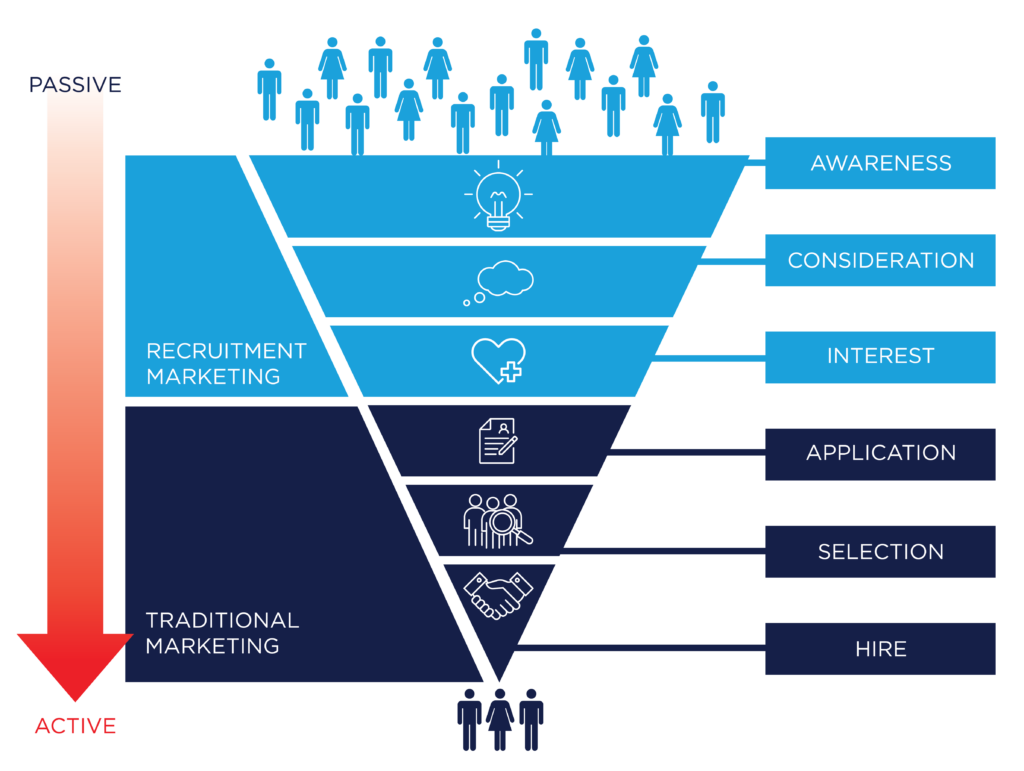
Some candidates will enter the recruitment cycle as mostly passive, while others may start out more active and receptive to your brand marketing campaign. The most important element for success is making sure that you are creating effective brand advertisements and targeted messaging that meets the candidate where they are in the process.
Passive candidates consume an average of 16 sources before selecting an employer, so your content must stick out and resonate immediately. You need to capture their attention by speaking to their needs and pain points to draw them into a relationship with you as quickly as possible.
Some of these relationships will take longer to develop—these are the passive candidates who can be resistant to change. Other relationships will generate active interest and a completed application much quicker. In each case, using the correct messaging to cultivate these relationships and draw in the candidates you need is essential.
Timing and targeting are everything.
Stage 1: Not Looking
Aware but not interested
Passive candidates are the untapped oil field in talent acquisition. In the United States, these candidates are the largest and most experienced group of professionals in the country—and they’re the key to winning the War for Talent in 2024. This is especially true in ultra-competitive fields like aerospace, IT and cybersecurity, and high tech manufacturing.
We define passive candidates as currently employed workers who are not looking for other opportunities. On most days, they’re content with their current position. However, they remain engaged with their industry and pay close attention to what other companies do by consuming advertising, media campaigns, and networking with friends and family working there. Additionally, they stay informed through industry-specific websites and social media platforms.
What the Candidate is Doing:
- Consuming Brand Advertisements
- Browsing Social Media
- Reading News Articles
- Attending Industry Events
- Following Company Blogs
- Reacting to LinkedIn Posts
What the Marketing Should Do:
- Build Brand Recognition: Passive candidates may need repeated exposure to your brand to build recognition and goodwill.
- Grab Their Attention: Create social media posts and advertisements with stunning visuals and attention-grabbing copy.
- Stand Out from the Crowd: Differentiate your company by highlighting strengths, work-life balance, community engagement, and career advancement opportunities.
- Call to Action: Invite candidates to follow your company for updates and to reach out for an introductory conversation to “learn more.”
Marketing Channels:
- Organic & Paid Social Media: Reach tens of thousands of passive candidates with both organic and paid social media advertising.
- Digital Display Advertising: Build brand awareness by featuring the company logo and elevator pitch in digital advertisements.
- Sponsored Content: Create sponsored content, such as articles and op-eds, for industry-leading news sites to reach a large number of relevant readers.
- Industry Events: Attend conferences, expos, and panel presentations to build brand recognition and interact with passive candidates in person.
- Website Blog: Create and nurture a blog for your company’s website. To increase interaction, consider capturing email addresses for a newsletter.
Earned Media: Work with reporters and news publications to announce new product offerings and share exciting news without paying for placement.
Stage 2: Curiosity
Exploring the possibilities
Have you ever browsed LinkedIn during a lull and seen a job alert pop up? Do you ever get invitations to “Congratulate your friend” on a new job? Every LinkedIn professional gets these alerts daily—and for some, these alerts tickle their curiosity. Even if their interest is piqued for just a moment, they suddenly become curious about their career possibilities and open to the idea of finding an exciting new job.
If your talent acquisition strategy includes compelling advertising with the right messages, you can take advantage of this engagement to make passive candidates curious and start to draw them closer to your brand.
What the Candidate is Doing:
- Engaging with branded social media posts on LinkedIn and X (Twitter)
- Reading blog posts about a company’s new initiative or community outreach
- Browsing company culture and about us pages to gauge their interest
- Following a company page on LinkedIn for regular updates
What the Marketing Should Do:
- Be Relevant to Passive Candidates: Design targeted advertisements demonstrating company culture, work-life balance, and job roles.
- Be the Expert: Create well-researched, high-quality articles and whitepapers that demonstrate thought leadership and subject matter expertise. The best candidates want to work with a leader in their industry.
- Build Trust: Proactively answer the questions “Why should I leave my job and join your company?” and “What would life be like as an employee?”
Marketing Channels:
- Organic & Paid Social Media: Get articles, blog posts, and company updates in front of candidates and decision-makers with paid spots in social media feeds.
- Sponsored Content: Enhance the reach of articles and op-eds by paying for sponsored placement on news sites like Forbes, AL.com, and other TV and publisher news sites in the markets where you need them.
- Digital Display Advertising: Post stunning company advertisements on websites that cater to the defense tech and IT sectors, using candidates’ search behavior and content consumption habits to craft messaging and targeting.
- Industry Events: Speak one-on-one with passive candidates to build a relationship and prime candidates for direct outreach. Attend relevant job fairs and bring your talent acquisition team to build brand awareness and foster new relationships.
- Website Blog: Share employee success stories, new project announcements, community involvement, and company events to generate interest.
Stage 3: Consideration
Digging Deeper
If you successfully piqued a candidate’s interest during the curiosity stage, they’ll gradually begin to dig deeper. Because of this sustained engagement, they’ll already have strong brand recognition and a sense of loyalty to your company. This hard-won trust is essential to moving passive candidates through the recruitment process, and they’ll begin to consider your company as a serious career prospect.
During this stage, candidates will ask themselves:
Is this a good culture fit?
Will I be fulfilled at this company?
What will my work-life balance be?
Am I interested in any of their open positions?
How will my work protect our nation and help my community?
What will my long-term prospects and career progression look like?
What the Candidate is Doing:
- Reading to learn more about the company, culture, and values
- Looking for “Day in the Life” and “Why I chose ____” videos
- Diving deep to see diversity, veterans, and other social initiatives
- Learning about a specific team or department that matches their interests
- Proactively scrolling through the company’s LinkedIn for updates
- Reaching out to current and former company employees in their network
What the Marketing Should Do:
- Re-messaging Campaigns: Repeat and segment critical information on website pages and content likely to be visited by candidates.
- Geofencing Candidates: Target passive candidates employed by competitors by displaying ads to internet users located in and near their offices.
- Team Profiles: Feature profiles of specific teams and departments so candidates can visualize themselves at your company and working with their future team.
- Employee Referral Programs: Encourage current employees to identify candidates and promote the company brand to other professionals.
Marketing Channels:
- Hyper-targeted Digital Displays: Build responsive digital display campaigns featuring blog content and videos.
- Re-messaging: Create personalized messages and visual images based on pages previously visited.
- In-Video Advertisements: Place video advertisements for a target audience at the beginning, middle, and end of online videos.
- Paid Social Media: Reach thousands of candidates with videos on LinkedIn and Facebook using paid placement.
- Search Engine Marketing: Optimize your company’s website, blog, and thought leadership pieces to reach Google’s page 1 search results.
Stage 4: Tell Me More
Reaching out for advice
We’re in the middle of the Age of Information. Savvy consumers rarely make an appliance purchase without consulting the internet and reading reviews, and job seekers are no different.
Once a candidate has decided to consider your firm as a potential employer, they’ll seek out the inside scoop to learn more about the culture first-hand from past and present employees. That’s why it’s essential to create a compelling story about your company by placing employee testimonials front and center. You can also provide candidates with opportunities to engage with employees before the application and interview stage through their professional network, social media, webinars, and in-person events.
What the Candidate is Doing:
- Searching their network to speak with current and former employees
- Submitting a resume, filling out a short job application, or talking to recruiters
- Reading company reviews on Indeed, LinkedIn, and Glassdoor
- Re-reading company blogs and social media for workplace clues
- Watching employee and client testimonials on your website and social media
What the Marketing Should Do:
- Employee Testimonials: These are some of the most potent tools in candidate marketing. Have current employees create video testimonials demonstrating their life at the company and why they chose to work there.
- Utilize a Candidate Advisor: Work with HR to hire a candidate advisor to speak with potential employees in a low-stakes, informational conversation.
- Build a Short-form Application: Create a short form that allows candidates to express interest without committing to a complete job application.
- Create a Webinar or FAQ Video: Involve front-line employees to create a frequently asked questions (FAQ) video that answers common questions and personalizes the hiring process.
- Targeted Re-messaging at Candidates: Promote the short form, candidate advisor program, and FAQ videos to visitors who previously viewed relevant recruitment content.
Marketing Channels:
- Digital Display Networks: Use digital display networks for previous visitors to maintain brand awareness and keep your company top-of-mind for passive candidates.
- Social Media: Regularly post employee testimonials and FAQ videos, and promote candidate advisors to followers.
- Website Content & Forms: Create easily accessible website content and forms to secure contact information for passive candidates. Use re-messaging to include a call to action and links to this content across the website.
Stage 5: OK, I’m in
Formally applying for the job
Once a candidate has decided to apply, your job still isn’t done. You should continue to highlight the benefits of working at your company throughout the application, interview, and offer stages. It’s also critical that the application process itself is designed with user experience in mind.
Have you tried the ATS application process on a cell phone? Remember, the best prospects are passive and might be applying on their phone while at work to be discreet.
Few things will turn qualified candidates away faster than a cumbersome application portal and redundant steps that build frustration. In this tight labor market, high tech workers are in demand, and they know it. The best companies understand this dynamic and build streamlined application portals that auto-fill information from a candidate’s resume, allow them to complete the application in just a few clicks, and demonstrate that you value their time.
What the Candidate is Doing:
- Searching for your application portal and required information
- Researching the length of time and number of interview rounds at your company
- Using the application process to assess company culture, red flags, and employee appreciation
What Marketing & HR Should Do:
- Test the Application Process: Test the application process yourself, searching for duplicate work and unclear instructions, and identify chokepoints where users are likely to quit. What’s the minimum amount of information you need to get candidates on-the-hook and start a conversation? Do you have a short informational form to facilitate this?
- Solicit Third-Party Feedback: Ask colleagues and professional contacts to review the application process and provide critical feedback.
- Consolidate Information Requests: Limit the number of information requests to simplify the application process. Use an ATS that automatically extracts data from resumes.
- Bring in a User Experience Expert: Hire a user experience developer to create a seamless and easy-to-navigate application portal.
- Streamline the Interview Process: Candidate surveys repeatedly highlight numerous interview rounds as the most frustrating part of the job search. Consider how to streamline this process into two or three rounds.
Marketing Channels:
- Company Website: Integrate user experience into every aspect of your online presence, particularly your application portal.
- Applicant Tracking System (ATS): Choose an ATS that streamlines the process, automatically strips resume data, and offers single-page applications. Avoid keyword restrictions and applications that take longer than 5 minutes.
- Third-Party Job Boards: Use third-party job boards, such as LinkedIn, Indeed, and Ladders, to find more candidates and expand your brand’s reach.
- Social Media: Have in-house recruiters broadcast job openings and company information to their professional networks and active job seekers. Ask them to contact candidates they’ve successfully placed in the past for references. Additionally, consider implementing a quick-apply feature via a social form, capturing essential information such as name, phone number, email, and the desired position to initiate the application process.
Stage 6: Hired!
I’m a brand evangelist!
While many companies view signing an offer letter and an employee’s first day as the finish line, we know that’s just the start of their journey as a brand evangelist. The best organizations maximize the impact of new hires by keeping them excited about the brand, their position and role within the company, and the future.
Maximize recruiting investments by cultivating this excitement and transforming new hires into brand evangelists. Employees who retain enthusiasm can help reach new passive candidates and increase brand awareness through word-of-mouth and social media.
What the Candidate is Doing:
- Announcing their new job on LinkedIn and Twitter
- Shouting out their new team and coworkers on social media
- Sharing company updates and thought leadership pieces to their network
- Describing their excitement about your company with former coworkers
- Telling family and friends about their new role in person
Food for Thought: How do you keep new hires engaged and avoid flight risks during the additional clearance and background checks required before onboarding?
What the Marketing & HR Should Do:
- Company Social Media: Have a member of the employee’s new team announce their hire and express excitement for them to join the department.
- Employee Testimonials: Record a video (1-2 months after onboarding) so they can share their enthusiasm for the new role and what they love most. Consider creating a text- and photo-based testimonial for the website.
- Personal Social Media: Encourage new employees to announce their new role on LinkedIn, reaching their entire network and former coworkers in the field.
- Internal Support Groups: Connect new employees with support groups (diversity- or interest-based), mentoring programs, and other benefits.
Marketing Channels:
- Organic Social Media: Shoutout the new employee using the company’s official social media and encourage new hires to announce their role on LinkedIn.
- Paid Social Media: Pay to boost new hire social media posts to relevant audiences, like candidate targets and competitor employees using geofencing.
- Press Release Blog: Create press releases for new employees using the company blog. Consider releasing press releases to news wires for senior hires and department leaders.
- Recruiting Website Content: Add new hire shoutouts, video and written testimonials, and team photos to the “Careers” and other recruitment-focused pages on the company website.
With international conflict, growth of AI and the constant challenging landscape of cyber security, the defense and high tech sectors are poised to achieve record growth in 2024.
Despite these promising developments, defense and high tech contractors often scramble to hire enough qualified workers and rapidly scale departments to meet delivery schedules. The nation continues to struggle with historically low unemployment and the battle for tech specialists, especially those with security clearances, has never been fiercer.
AMG Defense Tech is helping defense and high tech contractors win the War for Talent by embracing unconventional hiring strategies like brand marketing and targeted content to woo passive candidates and break into the nation’s largest talent pool. We also work to identify feeder markets outside major metro areas and position their firms as top destinations for the country’s most desirable candidates.
Contact AMG Defense Tech today to rapidly scale production by marketing to the best high tech talent in the nation. Want to see other job categories or markets for hiring competitiveness and who’s competing/stealing your candidates? Reach out to the AMG Defense Tech Team.
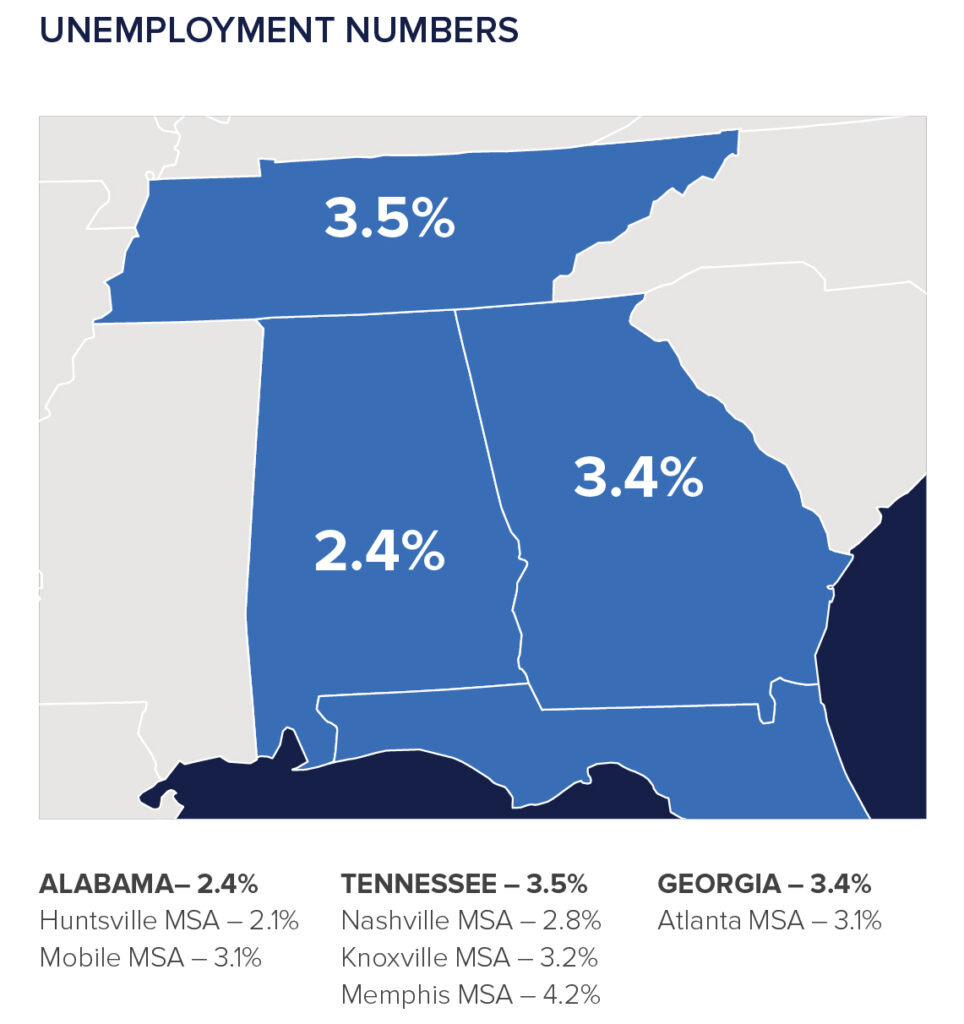
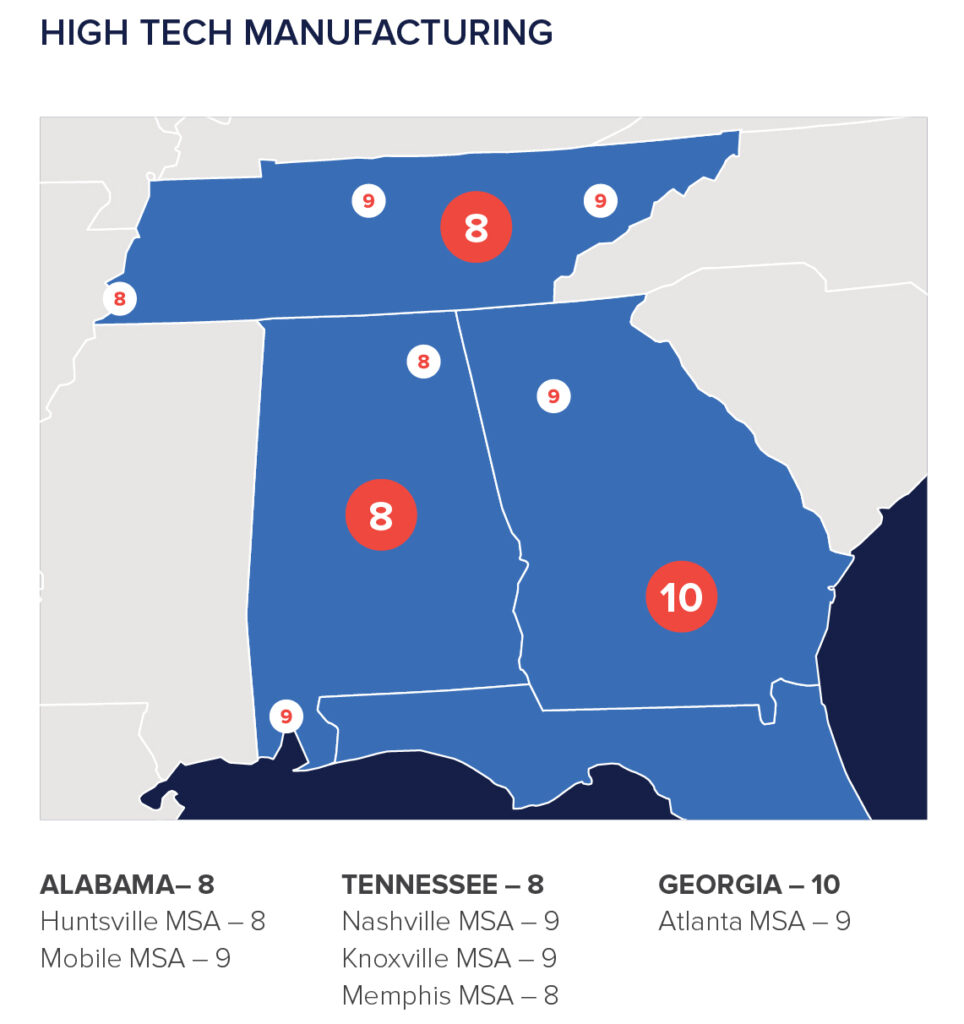
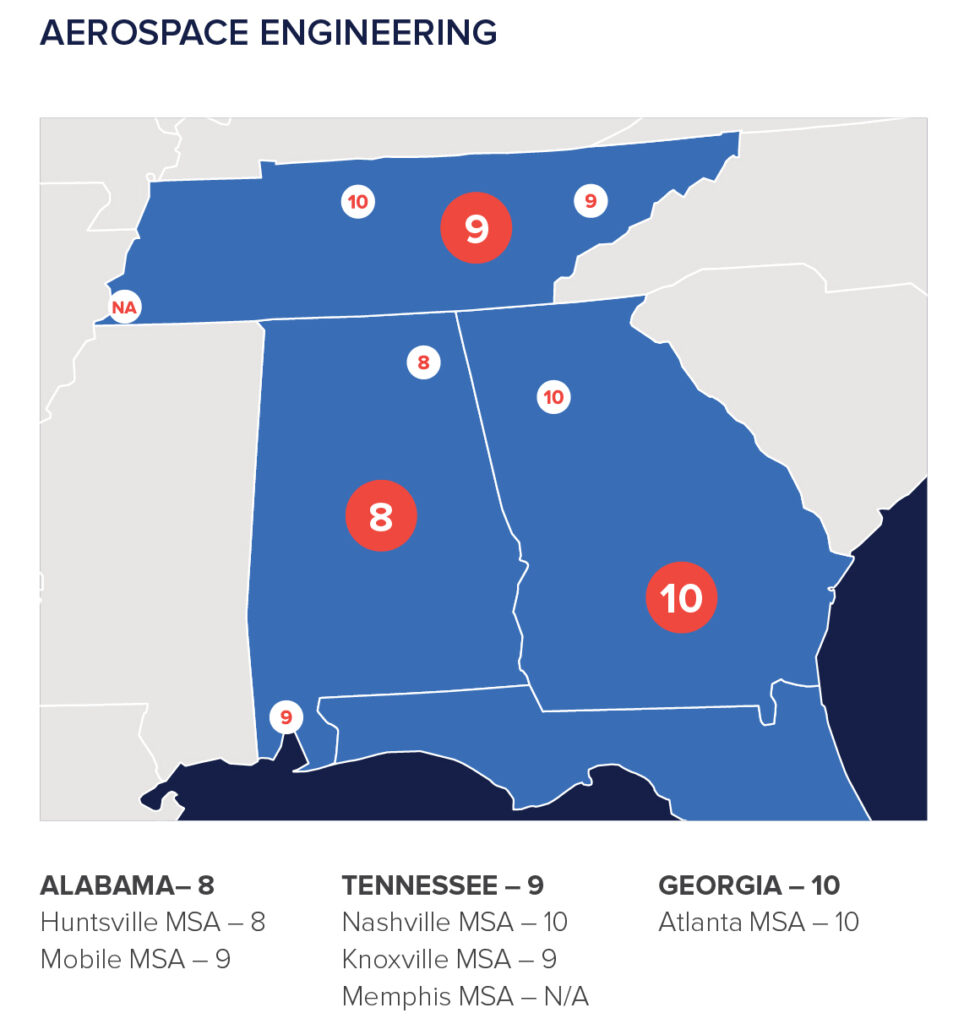
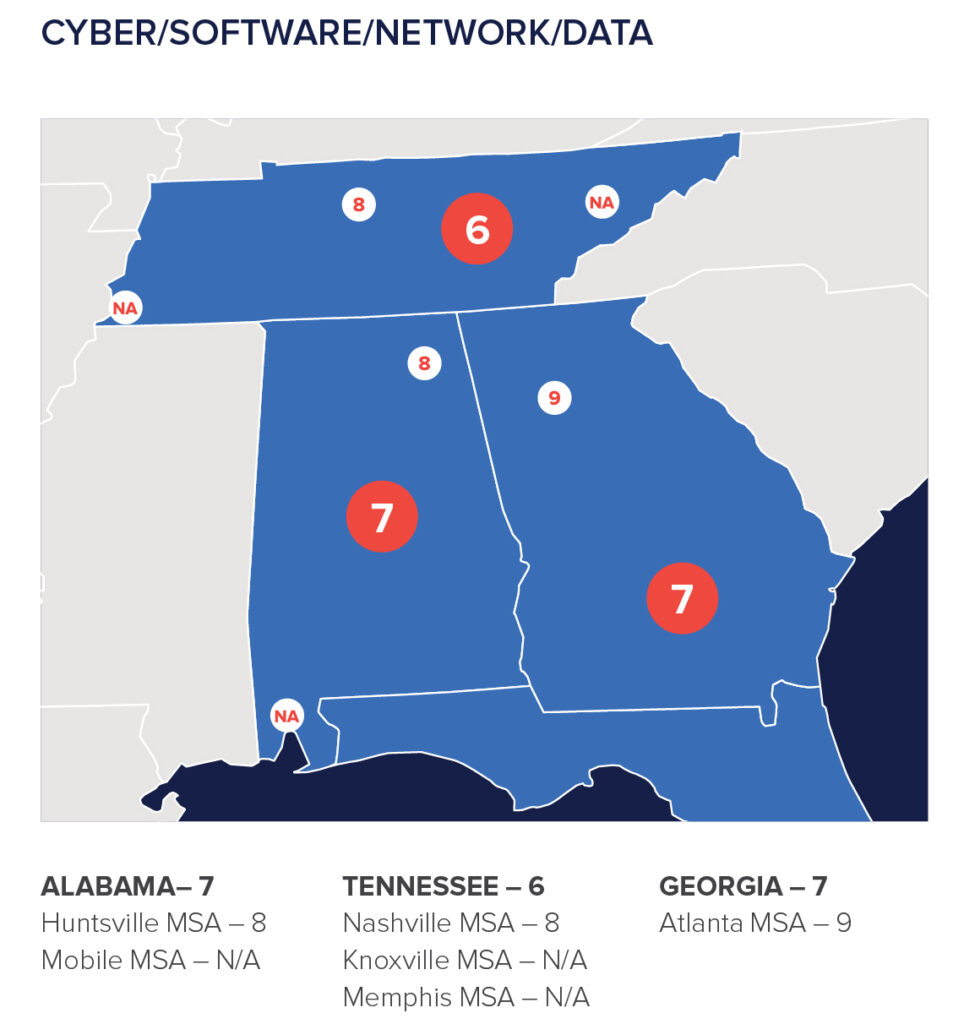

 Ad Choices
Ad Choices